More than 80% of leads don’t turn into new customers.
Why? The leads aren’t very good.
Only 8% of salespeople believe that they’re being provided with high-quality leads.
So, to counteract this, the best sales reps seek out their own leads. But seeking out your own leads can be challenging.
In fact, prospecting is often cited as the most difficult and time-consuming job in sales.
So, should sales professionals generate their own leads?
We surveyed 50 B2B sales leaders to ask them this very question.
By analyzing their answers, we uncovered the top five reasons why you and your sales team should consider generating your own leads. Also, we’d like to offer four ways you can use to start generating your own leads.
Why should sales reps generate their own leads?
The sales industry typically attracts competitive people who love winning deals and outperforming their colleagues.
One attribute that separates the highest-performing sales reps from the rest is their ability to generate their own leads.
During our research, we found five universal truths that outline exactly why sales reps should generate their own leads.
1. Additional leads help you exceed quota
Sales is a zero-sum game – you either win the business or you don’t.
In the same way, sales reps either exceed their quota or they don’t.
The best sales reps are not only more efficient and productive than their colleagues, but they will also do whatever it takes to exceed their quota each year.
This is because exceeding their sales quota typically enables sales reps to unlock additional commission or bonuses, increasing their earnings as a result.
According to 84% of the B2B sales leaders we spoke to, one of the biggest reasons for sales reps to generate their own leads is to help themselves exceed their quota.
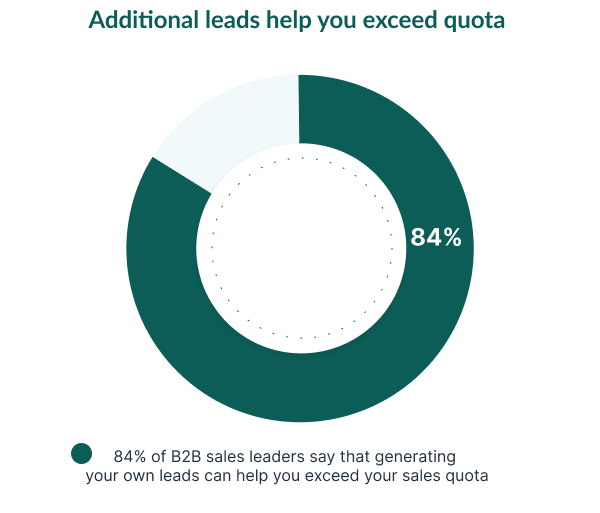
Not only will these personally generated leads increase the overall value of their sales pipeline, but salespeople will also be more likely to close them.
With only 60% of salespeople exceeding their quota each year, having an additional stream of leads can be the difference between success and failure.
2. Get more ownership over your sales pipeline
Top-performing sales reps like to run the full sales cycle themselves, nurturing their own leads from the point of generation through to deal closure.
This allows them more control over the quality of leads they work on and increases their level of ownership of their sales pipeline.
This is echoed by our research which found that 68% of B2B sales professionals believe that sales reps should generate their own leads to achieve more ownership of their pipelines.
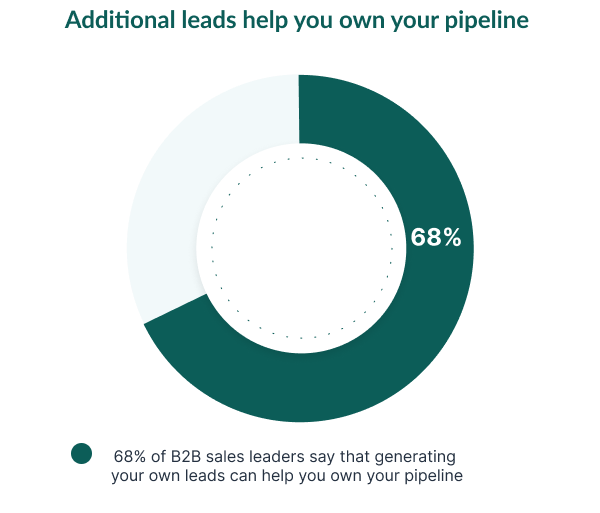
In doing so, sales reps get several advantages:
- Being in control of where the deals in their pipeline come from
- Having the opportunity to focus on deals they know will be closed
- The chance to increase their pipeline value
3. Build your own career prospects
“You’re only as good as your last deal” – or so the sales stereotype goes.
But how true is it really? … Well, it depends.
Salespeople who rely solely on the deals handed to them by their marketing team are pretty expendable.
If performance drops, then the sales reps who don’t go the extra mile will be the first ones to be shown the door during downsizing.
To counteract this, top-performing salespeople don’t just consider generating their own leads as a ‘nice to have’ – they see it as an essential way to enhance their career prospects.
This is backed up by the 64% of B2B sales professionals we spoke to, who all mentioned the positive impact of self-generated leads on sales reps' career prospects.

There are two key ways that generating leads for yourself can affect your sales career.
Building a personal brand
It’s not unusual for a sales rep to focus on a specific niche, either when targeting ideal customers in a certain sector, or by positioning themselves as an expert in their industry.
The next time you log on to LinkedIn, for example, you’ll spot several top-performing salespeople who are generating their own leads this way.
By doing so, not only will they be able to generate more leads, but you’ll also build a personal brand which opens doors to further opportunities, including:
- Conference talks
- Contributing to content like eBooks or podcasts
- Building a better network
By cultivating their own personal brand, not only do sales reps have a higher value for their current employers, but potential employers may also be keener to recruit them, too.
Proving your value to your company
Taking matters into your own hands as a sales representative and generating your own leads shows initiative.
Not every employee will be able or willing to demonstrate such a proactive attitude, despite the fact that employers highly value it.
Building your own pipeline in this way showcases your capabilities as a salesperson now and your potential for leadership roles in the future.
All of which can contribute towards pay rises and promotion opportunities that your other less-motivated colleagues may not be able to access.
4. Build enhanced relationships with prospects
Taking the time to generate your own leads as a sales rep is an activity that reaps dividends far beyond additional sales commissions or job promotions.
As a sales professional, you want to achieve all the personal rewards that come with enhanced performance and, ultimately, the satisfaction of a job well done.
With this in mind, generating your own leads also helps you to develop better relationships with your prospects, making your job easier and more enjoyable.
This is something that 56% of the B2B sales professionals we spoke to reflected upon.

By taking control of where your leads come from and managing the relationship, it allows you to:
- Gain rapport and a deeper understanding of needs earlier. This will enable you to become a trusted advisor quickly and put you in pole position to close the deal.
- Ensure a consistent approach with the prospect from day one. This will allow you to influence the deal and set expectations from the outset.
5. Diversify where your leads come from
The best salespeople generate leads from a diverse range of sources in order to:
- Ensure an ongoing supply of high-quality leads to work with
- Remove the dependency on any one particular source of leads
- Explore sources that marketing campaigns haven’t been able to tap into
- Increase their chances of closing more deals and achieving sales success
In fact, of the 50 B2B sales professionals we spoke to, 48% of them agreed that generating your own leads to avoid over-reliance on existing lead sources was crucial.
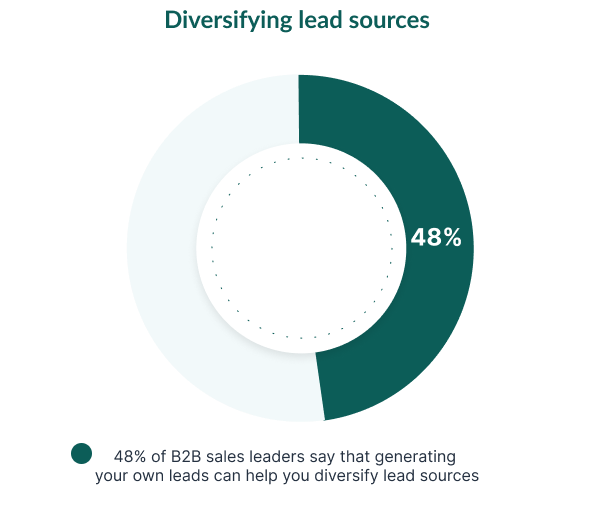
4 ways sales reps can generate their own leads
It’s clear that sales reps should generate their own leads as part of their sales pipeline.
To help, we’ve summarized some key actions your sales team can take and how they can use their CRM to support them in their sales process.
1. Events
If you’re focusing your lead generation efforts on a specific niche or industry, then there is no better way to gain access to large groups of relevant people than events, such as:
- Industry trade shows
- Conferences
- Speaking engagements
This could be as simple as “manning” the booth in the trade hall at a conference and speaking directly to interested parties through networking at mixer events.
You can also take things a step further by delivering a relevant and insightful conference talk that includes a call to action for attendees to contact you directly for details on your product.
Make sure you use your CRM as a central repository to collect all the contact information you’ve gathered and add it as leads to your pipeline.
You can also take advantage of automation within your CRM to remind you to follow up with these prospects after the event and to kick off the sales process with them.
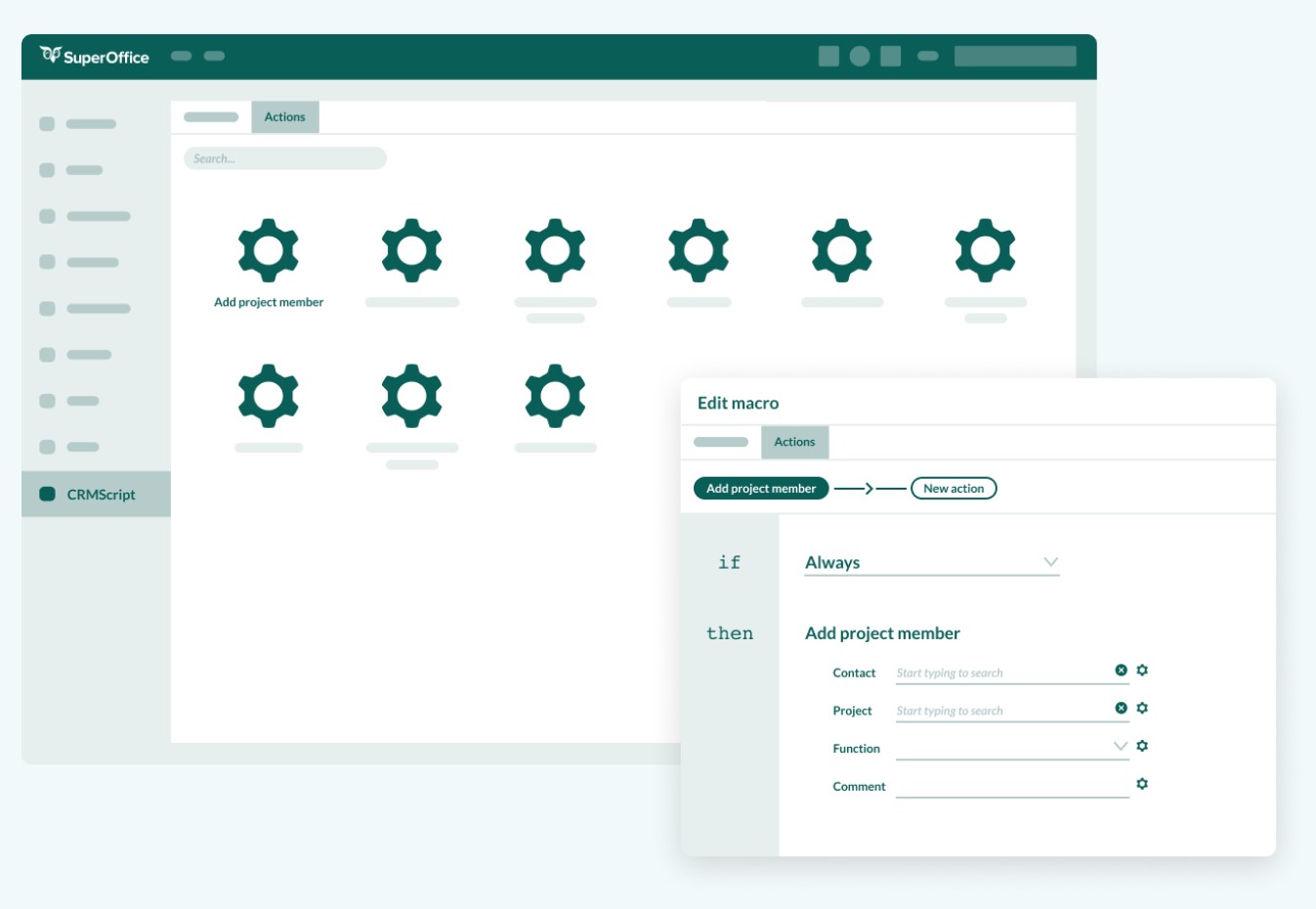
2. Cold outbound
As effective as events can be in providing an opportunity to speak to the right people, they tend to occur only at certain times of the year, so you’ll need other ways to generate leads.
This is where outbound sales can pay dividends for you, particularly in B2B sales.
When done right, outbound can provide a highly effective and targeted approach to lead generation.
If you want to focus on really specific target companies, you should take the time to research your list manually and gather information from websites.
Once you’ve built your cold outreach list, it’s important to manage this data carefully.
Rather than flooding your CRM with information for thousands of people who have yet to express interest in your product, it’s best to approach cold outreach outside your CRM.
Using dedicated cold outreach tools means you can integrate with your CRM to capture the data generated from your campaigns and add actual leads – people who respond to your message – to your sales pipeline.
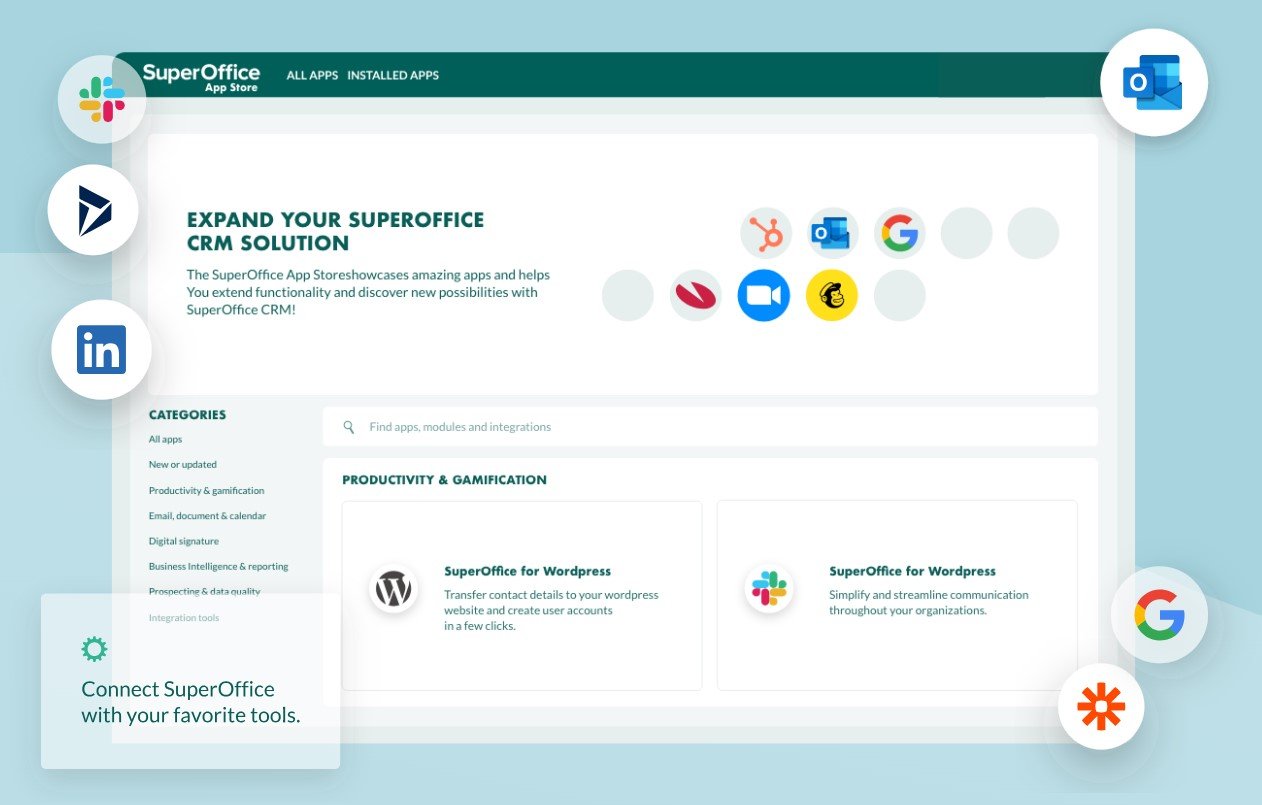
To help you get started with your next cold outreach campaign, we’ve prepared an email template for you to use, edit, and adapt as you wish:
Subject: [Your Company] <> [Recipient’s Company]
Hi [Recipient's Name],
My name is [Your Name], and I'm reaching out from [Your Company].
I wanted to introduce you to our solutions to help businesses like yours [solve specific problems].
We specialize in [brief description of your product/service] and have successfully helped companies in [industry or similar companies] increase [specific metric like revenue, efficiency, etc.].
I believe that [Recipient's Company] could benefit from [Your Company]'s expertise in [relevant area].
I'd love to schedule a brief call to discuss how we can tailor our solutions to meet the unique needs of your company.
Would you be available for a quick call sometime this week? Please let me know a time that works best for you, or feel free to suggest an alternative.
Looking forward to the opportunity to connect.
3. Referrals and networking
As salespeople become more established in an industry or sector, they will start to experience a “snowball effect” in their network.
What this means is that, over time, they will go from a few contacts to a fully connected group of people they can tap into, which becomes increasingly valuable when pursuing new sales leads.
There are two key ways your network can benefit you as a sales rep who is looking to generate their own leads:
- Referrals – directly reaching out to your network of customers, colleagues, and associates to ask for introductions to people they think are a good fit for your product or service.
- Connections – if you’re looking to get in touch with a specific person, sometimes a warm introduction from someone they already know can be far more effective than cold outreach.
You can use your CRM to segment existing customers to identify previous sales you’ve made in a target market and reach out to them to ask for a referral.

To help you get started with your approach to asking for referrals and introductions, we’ve prepared an email template that you can adapt and use as needed.
Subject: Intro Request
Hi [Mutual Contact's Name],
I hope you're doing well. I wanted to reach out because I'm exploring opportunities to connect with [Recipient's Name] at [Recipient's Company].
I've been following [Recipient's Company], and I'm impressed by their recent achievements in [mention specific area or project]. I believe there could be some valuable synergies between our companies.
Would you be comfortable making an introduction or providing guidance on the best approach to connect with [Recipient's Name]?
Any help would be gratefully received.
Looking forward to hearing from you.
4. LinkedIn
There is no substitute for using LinkedIn for social selling and lead generation.
While you can take a cold outreach approach with LinkedIn by using its built-in tools, such as “InMail”, to message target prospects directly, this isn’t always the most effective method.
Many of the best salespeople on LinkedIn will take the time to build a brand on the platform by posting relevant content to attract their target audience.
Below is an example of the kind of content you could expect to post as part of a personal brand-building exercise on LinkedIn.
This example is ultimately generating leads for sales training, but the same approach could be adapted to almost any industry or product.

By engaging with this audience and providing them with helpful information, you can become a trusted authority in the sector that people want to do business with.
While attending events or running cold outreach campaigns are activities you can switch on and off, establishing a brand and inbound funnel on LinkedIn requires consistency.
However, when done right, it can provide a steady stream of interest that can be converted to leads to add to your sales pipeline.
How a CRM platform helps you generate your own leads
As a sales rep, you should generate your own leads.
Doing so will help you:
- Exceed your sales quota
- Achieve greater ownership of your sales pipeline
- Improve your career prospects
- Build enhanced relationships with potential customers
- Diversify the source of leads you work on
However, you need the right tools in place to help you gather and manage leads from sources like events, cold outbound, referrals, and even LinkedIn.
A CRM platform, like SuperOffice, can help you manage the leads you’ve generated yourself.
Without a CRM, you will struggle to manage the leads you’ve generated, find it hard to demonstrate the value of the leads you’re adding to your pipeline, and waste time on duplicate leads.
With SuperOffice CRM, you can:
- Build ongoing relationships with prospects and keep consistent records
- Track the success rate of your leads vs marketing-generated leads
- Ensure your hard work is recognized and you own your leads
Ready to add more leads to your pipeline with SuperOffice CRM?
Book a demo of SuperOffice today and learn how to manage all your sales and marketing leads from one CRM platform.



